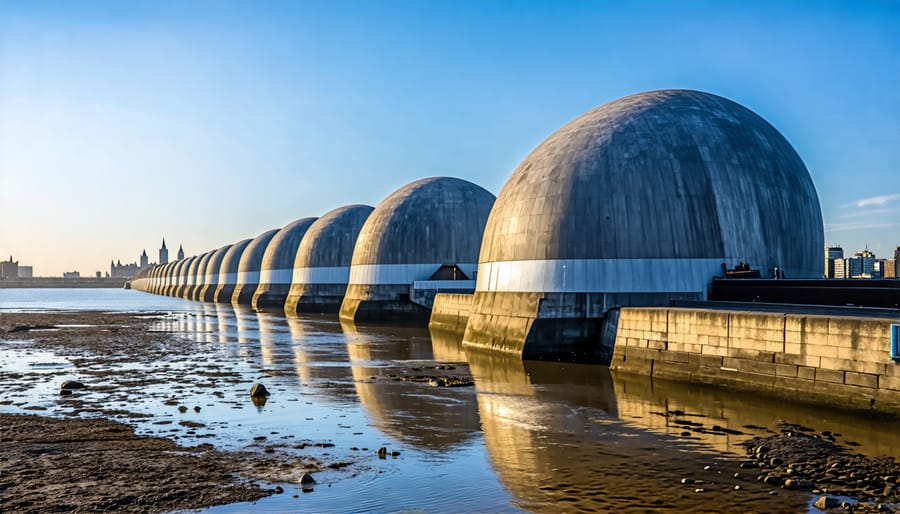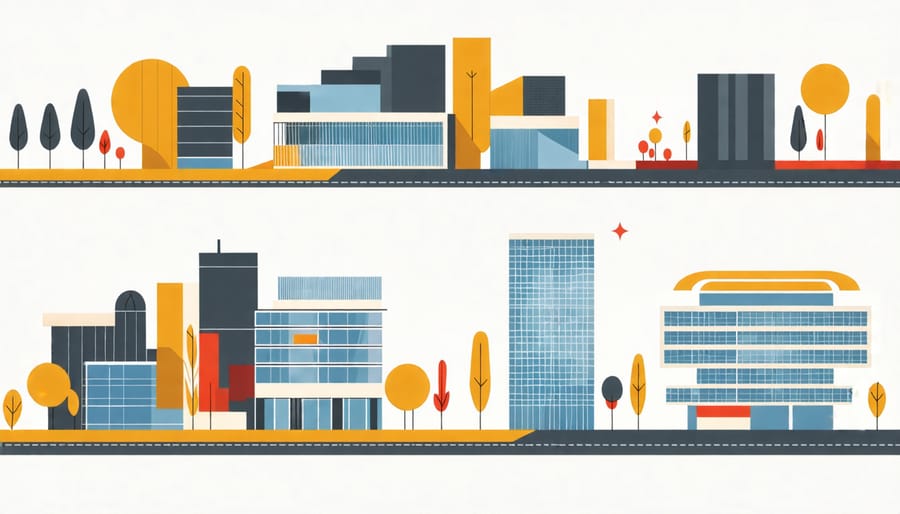Implement green roofing systems to mitigate urban heat effects while enhancing building insulation. Utilize permeable pavement to improve stormwater management and reduce flood risks. Incorporate seawalls and flood barriers along vulnerable coastlines to protect essential infrastructure from rising sea levels. Employ advanced materials like ultra-high-performance concrete for resistance against extreme weather conditions.
Understanding Climate Resilient Infrastructure
Key Characteristics
Climate resilient infrastructure is characterized by its ability to withstand and adapt to the inevitable impacts of climate change. This includes the use of durable materials that can resist extreme weather conditions and innovative design strategies that incorporate flexibility and redundancy. Such infrastructure often leverages advanced forecasting and modeling tools to anticipate future climate scenarios, allowing for informed decision-making and proactive adaptation measures. Key features also include integrated systems that enhance the resilience of communities, as well as sustainable practices that minimize environmental impact. Adaptive capacity is crucial, ensuring that infrastructure can adjust to changing conditions over time while maintaining operational integrity and safety.
Benefits for Urban Planning
Integrating climate-resilient infrastructure into urban planning significantly enhances city resilience. It ensures cities can withstand and adapt to climate-induced stressors, safeguarding both physical structures and communities. By emphasizing sustainable design and construction techniques, urban planners are better equipped to implement efficient climate resilience strategies that reduce vulnerability. This approach permits flexibility in zoning and enhances resource management, preventing disruptions to essential services. Moreover, it fosters collaboration among architects, engineers, and city officials, ensuring infrastructure not only meets current demands but is robust against future climatic challenges, ultimately contributing to sustainable urban growth.
Innovative Examples Around the World
The Thames Barrier, London
The Thames Barrier, located on the River Thames in London, is a vital piece of climate-resilient infrastructure. Constructed in response to severe flooding events, the barrier exemplifies how engineering ingenuity can safeguard major metropolitan areas from the threats posed by rising sea levels and storm surges. Spanning 520 meters, the barrier consists of ten movable gates that can be raised during high-tide events, effectively protecting London from floods. Since becoming operational in 1984, the Thames Barrier has shielded the city, reducing potential damages and maintaining business continuity. Its design anticipates future climatic changes, with the capacity to continue operation effectively until 2070, providing a long-term solution to evolving environmental challenges. An exemplary model of collaborative engineering, the barrier reflects a proactive approach to urban planning, where adaptive infrastructure plays a pivotal role in urban resilience and sustainability. By integrating robust technological systems, it sets a precedent for future projects aimed at mitigating the impact of climate change on urban environments.

Green Roof Initiatives, Singapore
Singapore’s Green Roof Initiatives serve as a compelling case study of urban adaptation strategies designed to combat rising temperatures and manage heavy rainfall, key elements of climate-resilient infrastructure. Spearheaded by the Housing and Development Board and other governmental bodies, these initiatives integrate vegetation into urban rooftops, reducing the urban heat island effect by absorbing less heat than conventional roofing materials. According to experts, these green roofs can decrease ambient temperatures by up to 3–4°C, enhancing thermal comfort in densely populated areas. Moreover, they play a critical role in stormwater management by absorbing rainwater, reducing runoff, and minimizing the risk of flooding. Engineers and architects have observed a notable improvement in building insulation, contributing to energy savings and reducing greenhouse gas emissions. Through rigorous planning and execution, Singapore has successfully enhanced urban sustainability, setting a benchmark for global cities facing similar climate challenges. The success of these green roofs underscores their value as a tool for sustainable urban development.

Floating Homes, The Netherlands
In the Netherlands, floating homes present an innovative solution for enhancing flood resilience, a critical consideration in low-lying and flood-prone regions. These structures are ingeniously designed to rise with water levels, leveraging buoyancy like a ship, which allows them to withstand flooding events that could otherwise devastate conventional homes. Constructed with advanced materials and anchored to flexible mooring systems, these homes offer a practical and scalable approach to managing water risks exacerbated by climate change. By integrating with water management strategies, floating homes exemplify forward-thinking infrastructure that not only ensures resident safety but also contributes to sustainable urban planning.
Technological Innovations Driving Resilience
Smart Materials
Smart materials have emerged as a cornerstone in creating climate-resilient infrastructure, offering adaptive capabilities that respond dynamically to the challenges posed by extreme weather conditions. These materials, including shape-memory alloys, thermochromic, and self-healing materials, offer innovative solutions by adjusting their properties in response to environmental triggers. Shape-memory alloys, for instance, can revert to their original form after deformation, making them ideal for structures that need to withstand severe wind loads or ground vibrations due to earthquakes. Thermochromic materials change color in response to temperature variations, providing a passive method of regulating building temperature and reducing HVAC demands. Self-healing concrete, imbued with bacterial agents, can autonomously repair cracks, significantly extending the lifespan of infrastructure exposed to severe weather fluctuations. These smart materials not only enhance durability and reduce maintenance costs but are pivotal in designing sustainable infrastructure that can endure the variances brought about by climate change, ensuring safety and functionality.

Data-Driven Planning
In the face of unpredictable climate challenges, data-driven planning is revolutionizing infrastructure design by leveraging big data and AI to enhance resilience. These technologies offer construction professionals invaluable insights by analyzing vast datasets encompassing weather patterns, soil conditions, and historical climate data. AI algorithms can predict potential climate-related impacts on infrastructure, enabling engineers and architects to design structures that withstand extreme conditions like floods and heatwaves.
For instance, machine learning models can optimize the placement of flood barriers by simulating various scenarios and assessing risks. Additionally, big data analytics provides actionable intelligence for selecting materials and designs that are both durable and sustainable. Through these advanced tools, project managers can make informed decisions that align with long-term environmental goals, ultimately facilitating the creation of infrastructures that are not only robust but also adaptive to future climate shifts.
By integrating data-driven planning into the construction lifecycle, industry leaders can ensure that infrastructure investments remain secure and effective amid evolving climate challenges.
Challenges and Considerations for Implementation
Economic Considerations
Navigating the funding landscape for climate-resilient infrastructure poses significant challenges, primarily due to the high initial capital investments required. Construction professionals and industry decision-makers must weigh these costs against long-term benefits, such as reduced maintenance expenses and enhanced durability in the face of extreme weather events. Financial sustainability also hinges on leveraging diverse funding sources, including governmental grants, private investments, and public-private partnerships. Innovative financing models, like green bonds or climate adaptation funds, are gaining traction to bridge funding gaps and incentivize sustainable practices in infrastructure projects. Furthermore, establishing clear metrics for evaluating cost-effectiveness and resilience value is essential for stakeholders to make informed, strategic decisions that align with both economic viability and environmental sustainability.
Regulatory Hurdles
Implementing climate resilient infrastructure faces significant regulatory hurdles that can impact the success of such projects. Navigating complex compliance landscapes can delay progress, particularly when integrating innovative methods like 3D BIM modeling. This process requires harmonizing existing building codes with new standards tailored for climate resilience, often involving rigorous environmental assessments. Additionally, the variability of regulations across regions further complicates project timelines and budgets. Compliance challenges are compounded by risk factors such as increased frequency of extreme weather events, influencing decisions on materials and construction techniques. Regulatory frameworks must evolve to support adaptive infrastructure investments, necessitating close collaboration among policymakers, construction professionals, and stakeholders. Successfully navigating these hurdles will require a concerted effort to balance regulatory demands with the urgent need for resilient solutions.
Expert Insights
In a rapidly changing climate, the construction industry is at the forefront of developing resilient infrastructure. According to Dr. Emily Chen, a leading environmental engineer, future trends will increasingly focus on adaptive designs that prioritize sustainability and longevity. She emphasizes the importance of integrating natural and built environments, creating structures capable of withstanding severe weather events while also promoting ecological balance.
John Martinez, an architect specializing in sustainable design, highlights the shift towards materials that not only have low carbon footprints but also enhance durability. He notes that innovative materials such as recycled steel, carbon-positive concrete, and engineered timber are gaining traction. These materials, he asserts, are central to a resilient construction strategy, offering both ecological and economic benefits.
Peter Williams, a policy advisor on urban planning, discusses the role of technology in advancing climate-resilient projects. He foresees the increased use of AI and data analytics in the planning phases to predict environmental impacts and optimize building locations and designs. Williams stresses that adopting these technologies will enable cities to prepare more effectively for climate-related challenges.
Overall, experts agree that the future of climate-resilient construction lies in multidisciplinary collaboration, technological innovation, and a steadfast commitment to sustainability. By prioritizing these elements, the industry can develop infrastructure that not only survives but thrives in the face of climatic uncertainties.
Conclusion
In conclusion, as the construction industry grapples with the mounting challenges posed by climate change, the significance of climate resilient infrastructure cannot be overstated. Investment in innovative construction technologies and materials is paramount to building infrastructure that not only withstands environmental stresses but thrives under them. By integrating insights gleaned from successful case studies and expert interviews, industry professionals can navigate the complexities of sustainable development more effectively. Key elements such as adaptive design, resource efficiency, and disaster risk reduction must be central to future projects. However, innovation alone is insufficient; robust policy frameworks are necessary to guide and incentivize sustainable practices. Collaboration between policy-makers and industry leaders is crucial to streamline implementation and maximize the impact of new technologies. As we move forward, the concerted efforts to prioritize resilience in infrastructure will play an essential role in safeguarding our built environment and ensuring its adaptability for generations to come.

